Stevia-sweetened cheesecake lets you indulge without the sugar overload. This natural sweetener is 50 to 300 times sweeter than sugar, making it perfect for cutting calories while savoring creamy goodness. You'll need high-quality cream cheese, eggs, and your favorite flavorings, blended to perfection. Bake until set, and enjoy the rich texture without the guilt. Top it off with fresh berries, whipped cream, or a drizzle of dark chocolate for an extra treat. By choosing Stevia, you're not just satisfying your sweet tooth; you're also making a healthier choice. Discover more ways to elevate this dessert for anyone you love.
Key Takeaways
- Stevia is a natural sweetener that can replace sugar in cheesecake for a guilt-free dessert option.
- A typical stevia-sweetened cheesecake includes cream cheese, Stevia, and various flavorings like pumpkin puree or fresh berries.
- Proper preparation techniques, such as using room temperature ingredients and avoiding overmixing, ensure a smooth and creamy cheesecake texture.
- Enhance your stevia cheesecake with toppings like fresh berries, whipped cream, or a drizzle of dark chocolate for added flavor.
- Stevia reduces the cheesecake's calorie and sugar content, making it suitable for those seeking a healthier dessert option.
What Is Stevia?
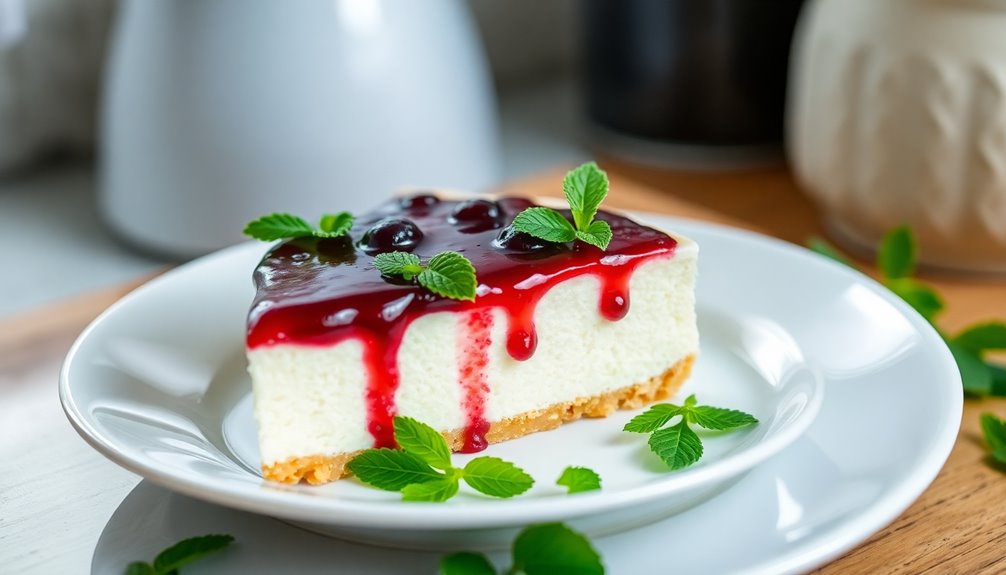
Stevia is a natural sweetener that's gained popularity for its ability to provide sweetness without the calories of traditional sugar. Derived from the leaves of the Stevia rebaudiana plant, it's about 50 to 300 times sweeter than sugar, making it a fantastic choice for those looking to cut back on sugar intake. When you compare stevia vs sugar, you'll notice that stevia offers a guilt-free alternative, allowing you to enjoy your favorite treats without the extra calories.
If you're venturing into the world of baking, you might be wondering how stevia holds up in recipes. Stevia in baking can be a game changer; it can enhance flavors while keeping your desserts light and healthy. While you might need to adjust your measurements—since stevia is much sweeter than sugar—it's relatively simple to incorporate. Just remember that using too much might lead to a bitter taste, so finding the right balance is key.
Embracing stevia opens up a whole new domain of possibilities in your kitchen. You can create delicious, lower-calorie versions of your favorite desserts, like cheesecakes or cookies, that everyone can enjoy. As you discover the versatility of stevia, you'll find yourself belonging to a community of health-conscious bakers who prioritize flavor without compromising on wellness. So, whether you're a seasoned baker or a curious beginner, stevia invites you to explore a new, sweet chapter in your culinary journey.
Benefits of Using Stevia
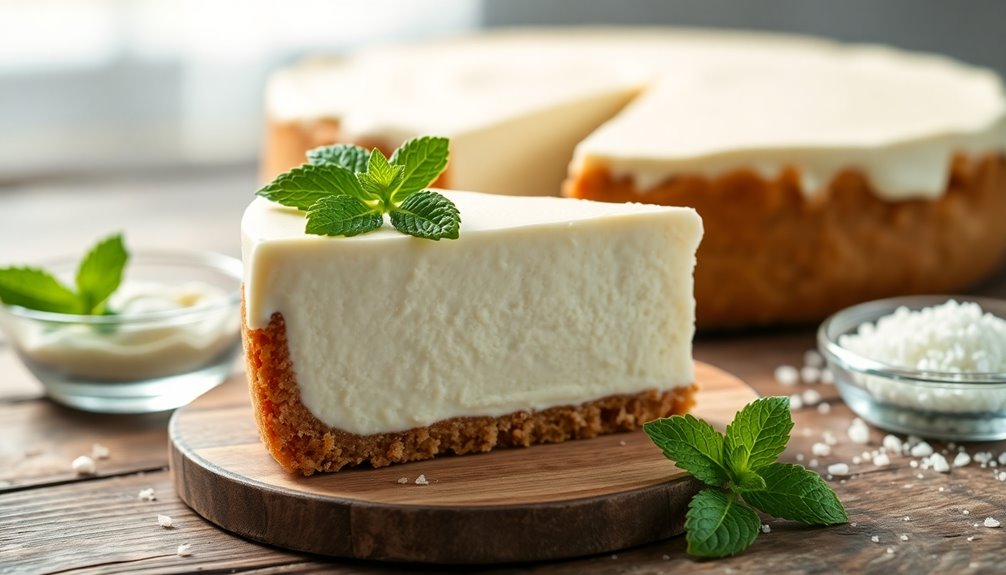
When you choose stevia as your sweetener, you're not just cutting calories; you're also embracing a range of health benefits. This natural alternative to sugar offers you a guilt-free way to enjoy your favorite desserts while keeping your wellness goals in check. Unlike many stevia alternatives, stevia itself is derived from the leaves of the Stevia rebaudiana plant, making it a fantastic option for those seeking a more wholesome lifestyle.
One of the most significant health benefits of stevia is its ability to help regulate blood sugar levels. If you're watching your sugar intake, you'll appreciate that stevia doesn't spike your glucose, making it a great choice for diabetics or anyone looking to maintain steady energy throughout the day. Plus, with zero calories, you can indulge in your sweet cravings without worrying about unwanted weight gain.
Additionally, stevia has been linked to potential health benefits like improved digestion and even antibacterial properties. Imagine enjoying a delectable cheesecake, knowing that your choice of sweetener supports your overall health and well-being!
Ingredients for Cheesecake
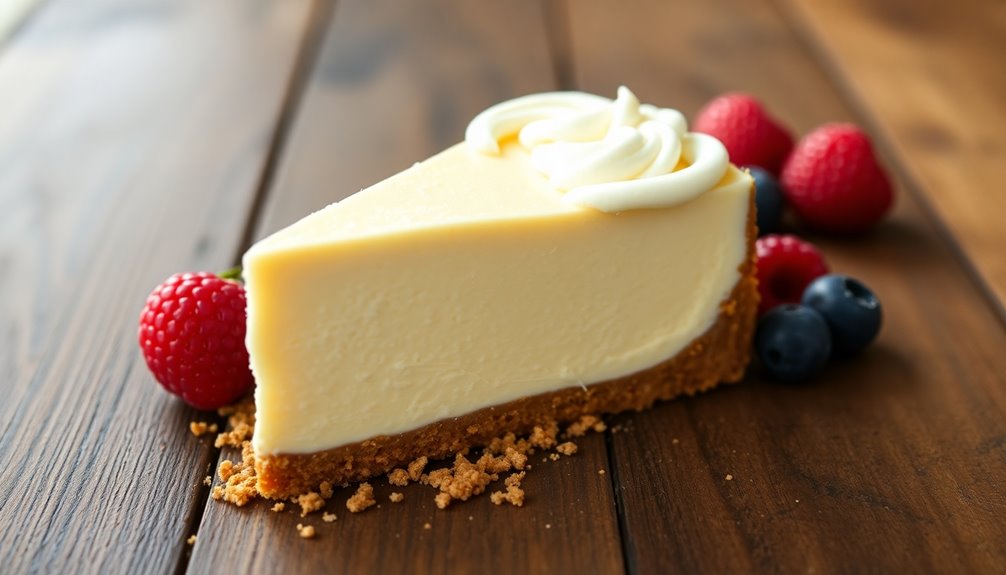
Creating a delicious stevia-sweetened cheesecake starts with gathering the right ingredients. You'll want to choose high-quality cream cheese as your base; it provides that signature rich, creamy texture. For a twist, consider exploring cheesecake variations like adding pumpkin puree for a seasonal delight or incorporating fresh berries for a fruity touch. Each variation opens up a world of flavor possibilities!
Next, don't forget the crust. A traditional graham cracker crust is a popular choice, but you can also use almond flour or coconut flour for a gluten-free option. This not only caters to different dietary needs but also enhances the flavor profile of your cheesecake.
For the sweetener, stevia is your star! It's an essential alternative that keeps your cheesecake sweet without the extra calories. If you're feeling adventurous, explore other sweetener alternatives like erythritol or monk fruit, which can complement stevia beautifully. You'll find that experimenting with these options can lead to a cheesecake that's uniquely yours.
Step-by-Step Instructions
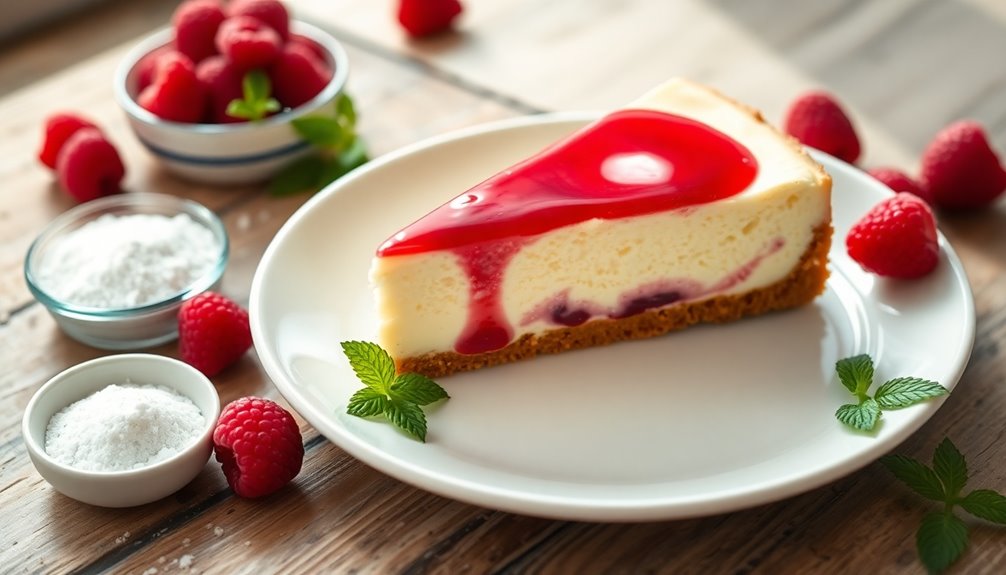
To whip up your stevia-sweetened cheesecake, start by preheating your oven to 325°F (160°C). This sets the perfect stage for your delightful dessert.
Next, grab a mixing bowl and blend your cream cheese until it's smooth and creamy. Incorporate your stevia, ensuring you've achieved a flavor that's just right. Don't rush this—perfecting the mixture is one of the essential baking techniques.
Once combined, add in your eggs one at a time. This helps to maintain that silky texture. Stir in a splash of vanilla extract for a classic flavor combination, or get adventurous with a hint of lemon zest or almond extract to elevate your cheesecake. The world of flavors is at your fingertips!
Now, pour your creamy mixture into a prepared graham cracker crust or a gluten-free option if that's your preference. Smooth the top with a spatula, making it visually appealing. Place it in the oven and bake for about 50-60 minutes. You'll know it's done when the edges look set, but the center still has a slight jiggle. This balance is key!
After baking, let it cool in the oven with the door slightly ajar, allowing the cheesecake to settle without cracking. Once it's at room temperature, pop it in the fridge for at least four hours, or overnight if you can wait! Enjoy the anticipation as you look forward to savoring each delicious slice.
Tips for Perfect Cheesecake

Achieving cheesecake excellence often hinges on a few crucial tips.
First, let's discuss your baking techniques. Begin by ensuring all your ingredients are at room temperature. This simple step assists in creating a smoother batter, which translates to a silkier texture. When mixing, use a gentle touch; overmixing can introduce air, leading to cracks in your cheesecake as it bakes.
Next, consider the baking environment. Using a water bath can help regulate the temperature, resulting in a beautifully baked cheesecake without those unsightly fissures. Wrap your springform pan in foil to prevent water from seeping in, and you'll be rewarded with a velvety finish.
Now, let's delve into flavor pairings.
While a classic vanilla cheesecake is always a hit, don't hesitate to experiment. Pair your stevia-sweetened cheesecake with hints of citrus, like lemon or orange zest, for a revitalizing twist. You might also try adding a swirl of berry puree or a touch of almond extract for depth. Each flavor can elevate your dessert, making it uniquely yours.
Variations of the Recipe

When it comes to variations of your stevia-sweetened cheesecake, the possibilities are as enticing as they're delicious. You can easily tailor this classic dessert to reflect your tastes and creativity. Start by exploring different flavor combinations.
Why not try a luscious raspberry swirl? Blend fresh raspberries into a puree and gently fold it into the cheesecake batter before baking. For a zesty twist, consider adding lemon or lime juice and zest; these citrus notes brighten the richness and create an invigorating contrast.
If you're in the mood for something indulgent, a chocolate version might be calling your name. Simply incorporate unsweetened cocoa powder into the batter or melt dark chocolate and mix it in for a rich, velvety texture. Don't forget about spices! A hint of cinnamon or nutmeg can add warmth and depth to your cheesecake.
Baking techniques also play a pivotal role in achieving the perfect variation. You might want to experiment with a water bath method to ensure even baking and a creamy texture. Alternatively, try a no-bake version if you prefer a lighter, airy cheesecake. This approach allows you to mix your ingredients and chill them in the fridge until set—simple and satisfying.
With these variations, you'll not only enjoy a delightful dessert but also create a sense of belonging by sharing your unique creations with friends and family. Embrace the joy of experimenting, and watch your stevia-sweetened cheesecake become a crowd favorite!
Serving Suggestions

After experimenting with delicious variations of your stevia-sweetened cheesecake, it's time to think about how to serve this delightful dessert. Elevating your cheesecake's presentation can transform it from a homey treat into a show-stopping centerpiece. Consider these topping ideas and plating techniques that not only enhance flavor but also create a visually appealing dish.
| Topping Ideas | Pairing Suggestions |
|---|---|
| Fresh berries | A drizzle of dark chocolate |
| Whipped cream | A side of fruit coulis |
| Crushed nuts | A scoop of vanilla ice cream |
| Citrus zest | Mint leaves for garnish |
When it comes to presentation tips, opt for a beautiful serving plate to showcase your cheesecake. You might want to slice it into perfect wedges and arrange them artfully on the plate. A sprinkle of cocoa powder or a light dusting of powdered sugar can add an elegant touch.
For added flair, consider serving your cheesecake with a colorful fruit coulis drizzled around the plate. This not only enhances the flavors but also adds a pop of color that invites everyone to dig in. Don't forget to garnish with a sprig of mint for that final touch.
With these serving suggestions, you'll create an inviting atmosphere that makes everyone feel at home. Your stevia-sweetened cheesecake will be the star of any gathering, leaving your loved ones craving more!
Storage and Shelf Life
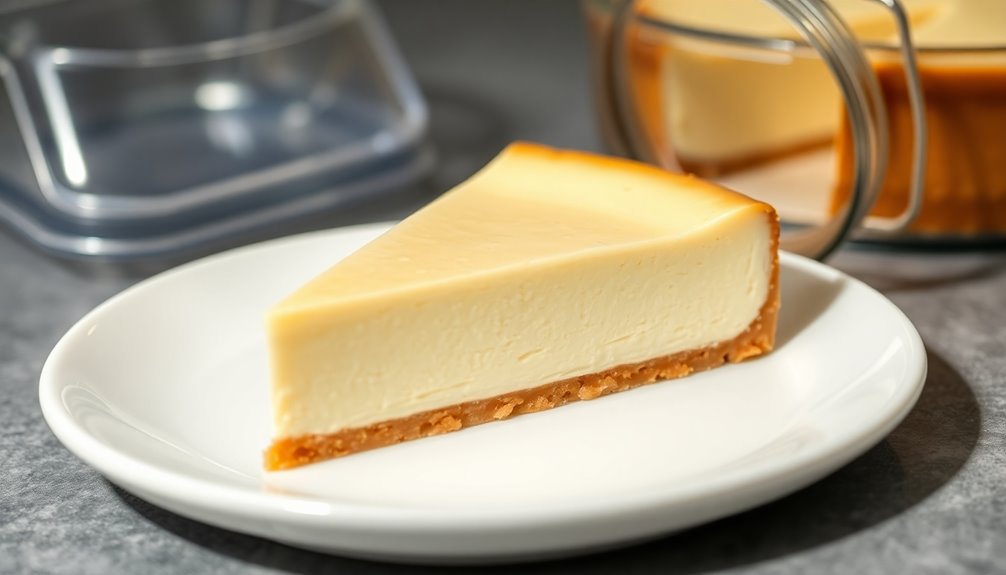
Proper storage is essential to maintain the freshness and flavor of your stevia-sweetened cheesecake. If you want to enjoy that creamy indulgence for days to come, following these simple guidelines will help [GUARANTEE] its extended shelf life and delightful taste.
- Refrigeration: Always store your cheesecake in the refrigerator. Cover it tightly with plastic wrap or place it in an airtight container to keep moisture out and prevent it from absorbing odors from other foods.
- Serving Size: Cut individual slices if you plan to share or enjoy it over time. This not only makes serving easier but also minimizes exposure to air, which can affect freshness.
- Freezing: If you need to store it for an even longer period, consider freezing your cheesecake. Wrap it well in plastic wrap and then in aluminum foil or place it in a freezer-safe container. This keeps it fresh for up to three months.
- Thawing: When you're ready to enjoy it again, thaw your cheesecake in the refrigerator overnight for the best texture and flavor recovery. Avoid thawing it at room temperature to prevent any unwanted bacteria growth.
Nutritional Information
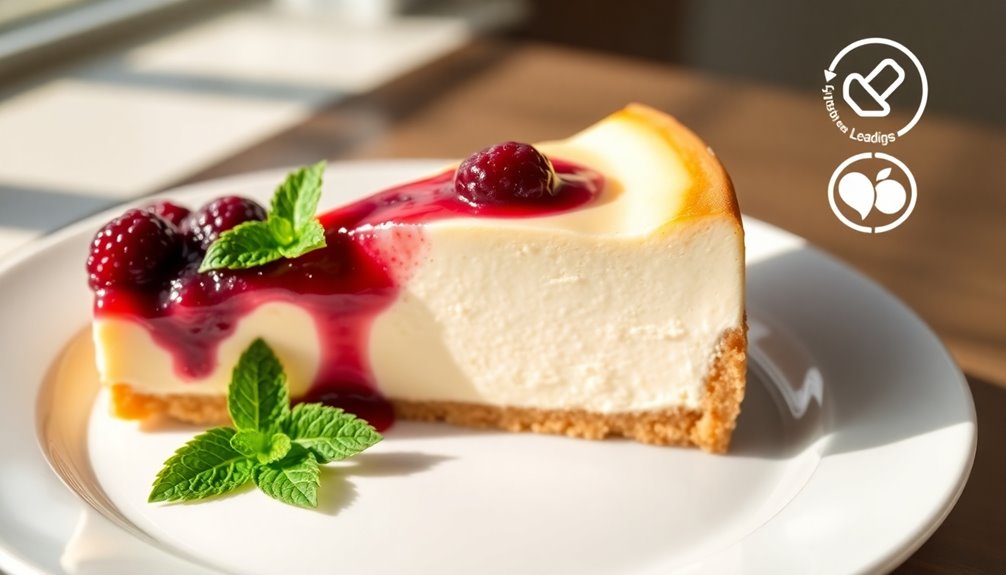
Nutritional information plays an essential role in understanding how stevia-sweetened cheesecake fits into your diet. This delightful dessert not only satisfies your sweet tooth but also offers a range of health benefits that make it a smart choice compared to traditional cheesecakes. By using stevia, a natural sugar alternative, you're cutting down on calories and sugar, making it easier to enjoy a treat without the guilt.
One slice of stevia-sweetened cheesecake typically contains notably fewer calories and carbohydrates than its sugary counterpart. This means you can indulge in your favorite dessert while keeping your diet on track. Plus, stevia has a low glycemic index, which helps maintain stable blood sugar levels—an essential factor for those managing diabetes or watching their sugar intake.
The health benefits of this cheesecake extend beyond just reduced calories. Stevia is rich in antioxidants, which can support overall well-being and may even contribute to improved heart health. By opting for sugar alternatives like stevia, you're not only making a delicious choice but also embracing a lifestyle that prioritizes health and wellness.
Incorporating stevia-sweetened cheesecake into your meals can create a sense of community, sharing a guilt-free dessert with friends and family. It's a wonderful way to bond over delicious flavors while nourishing your body. So go ahead and indulge—you'll feel good about your choice and enjoy the sweet moments together!
Frequently Asked Questions
Can I Use Powdered Stevia Instead of Liquid Stevia?
Did you know that nearly 60% of people prefer the taste of powdered sweeteners in baking?
If you're wondering whether you can use powdered stevia instead of liquid, the answer's yes! Just keep in mind that baking tips suggest adjusting the quantity; powdered stevia is often sweeter than liquid.
In a taste comparison, powdered versions can lend a different texture, so experiment to find the perfect balance for your recipe!
How Does Stevia Affect the Texture of Cheesecake?
When you use stevia in your cheesecake, it can subtly affect the texture. While the flavor impact is often pleasant, stevia may make your cheesecake a bit denser compared to sugar.
You might also notice changes in the baking time; it could take a little longer to set. Keep an eye on it while it bakes, as achieving that creamy consistency is key to a delightful dessert experience.
Is Stevia Safe for Children and Pregnant Women?
When considering if stevia is safe for children and pregnant women, weighing health concerns is crucial. Research suggests stevia has a favorable safety profile, but it's important to always consult a healthcare provider.
You'll notice its sweetness levels can enhance the taste profile of various foods without added sugars.
Can I Substitute Stevia for Sugar in Other Desserts?
Absolutely, you can substitute stevia for sugar in various desserts! When baking with stevia, remember it's much sweeter than sugar, so you'll need less. Experiment with different stevia alternatives, like erythritol or monk fruit, to find your perfect match.
Just keep in mind that stevia can affect texture, so adjust your other ingredients accordingly. Embrace this healthier option, and enjoy creating delicious treats that everyone can savor together!
What Brands of Stevia Are Recommended for Baking?
Did you know that over 30% of people prefer stevia for its zero-calorie sweetness?
When baking with stevia, you'll want to choose reputable brands like Truvia, Pure Via, or Monk Fruit in the Raw, as they provide a great taste without the aftertaste some others might have.
For tips, remember to adjust the liquid ingredients since stevia is more concentrated than sugar.
Enjoy your baking adventure with these delicious alternatives!
Conclusion
In the end, as you savor that creamy, stevia-sweetened cheesecake, you might just find a moment of bliss—a sweet coincidence that reminds you of life's simple pleasures. Each bite, a delightful fusion of flavor and health, brings comfort and joy, making it a perfect treat for any occasion. Whether you're sharing with loved ones or enjoying a quiet moment alone, this cheesecake is more than just dessert; it's a celebration of balance and well-being. Enjoy!



